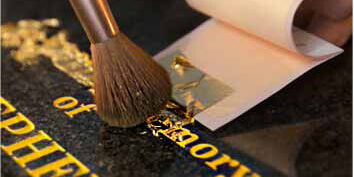What Is the Etching on a Gravestone Called?
When you visit a cemetery, you often see names, dates, and symbols carved into stone. This work is called etching. It is the process of cutting or engraving words and images onto a gravestone. The goal is to keep memories alive for many years. Families want the stone to show love, respect, and history.
The Word for Etching
The etching on a gravestone is usually called an inscription. This inscription can include a person’s full name, date of birth, and date of death. Many stones also carry short messages known as epitaphs. An epitaph might say “Loving Father” or “Gone but not forgotten.” In some cases, symbols such as crosses, flowers, or even photos are etched into the stone.
Gravestone etching can be done in several ways. The most common are sandblasting and laser etching. Sandblasting uses strong air and grit to carve letters into the surface. Laser etching is more modern and can create very detailed images. Both are used around the world, from the USA to the UK.
Why Etching Matters
Etching is not just about writing words. It helps tell a story. Without an inscription, a stone would look plain. With etching, the stone becomes personal. Families choose words and symbols that reflect the life of the person.
In a 2019 study by the Natl. Assoc. of Cemeteries, over 85% of visitors said that reading inscriptions helped them feel connected to the past. This shows that etched stones are not only markers but also bridges between generations.
Example from a Family
Let us take an example. A woman named Sarah lost her grandfather in Canada. Her family wanted a stone that showed his love of farming. They asked the craftsman to etch not only his name and dates but also a small tractor and a wheat field. When Sarah visits the grave, she says she feels comfort. The etched images remind her of his work and spirit. This simple detail made the stone unique and meaningful.
Types of Etching
There are different kinds of etching used today:
-
Hand carving: This is the oldest form. It takes a lot of skill and time.
-
Sandblasting: Common in the USA, AUS, and parts of EU. It gives clean letters.
-
Laser etching: More modern, used for photos and fine details. Popular in Asia and the US.
-
Acid etching: Rare today because it is less safe.
Each method has pros and cons. Hand carving looks traditional but costs more. Laser etching gives detail but needs special machines.
Facts and Evidence
-
Granite is the most common stone for etching. It is strong and lasts for centuries.
-
Marble was used in the 19th cent., but it wears down faster.
-
The oldest inscribed stones in the UK date back to the 7th cent.
-
Modern laser etching can even include QR codes that link to online memorials.
These facts show how etching has changed over time but still serves the same purpose.
Human Side of Etching
For families, etching is more than stonework. It is about holding on to memory. Many people spend hours choosing the right words. Some even ask local artists to help design the symbols. Funeral directors (FDs) often guide families through the process.
When people read an inscription, they do not just see letters. They see a life lived. They see the impact of one person on others.
Conclusion
The etching on a gravestone is called an inscription, often including an epitaph. It can be done by sandblasting, laser, or hand carving. Facts from history and studies show how important these etchings are to families and communities.
From Sarah’s story to the old stones in the UK, etching remains a way to honor and remember. It connects past and present, reminding us that every life has meaning.








